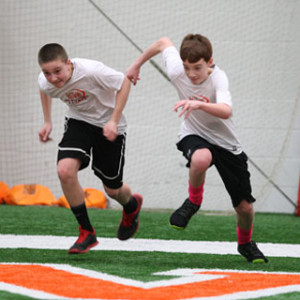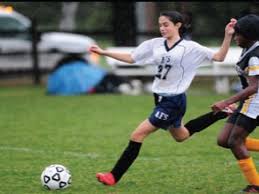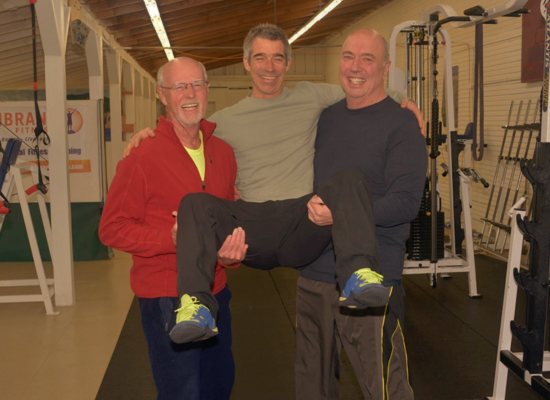Having started my fitness training career as a largely “unspecialized fitness trainer” in a small town, I have had the opportunity to train a wide range of people and populations over the years.
Please, don’t ask me to name my favorite training populations or situations here. Truthfully, I love them all.
But I will say that training youth athletes is very dynamic, and very satisfying.
While I now specialize in training 50 and 60-somethings, working with kids has always been an important part of my life.
Being a certified Waldorf teacher has given me tremendous insight into child/human development.
And to me, “kids at play” is one of the great wonders of the world.
When someone between the ages of 12 and 20, already engaged in a sport, is ready for professional fitness training, progress and results happen fast! (A remarkable number of college-level athletes arrived at college without ever having worked with a professional fitness trainer)
This population may get more “bang for the buck” from general fitness and beginning strength training than any other, for a number of reasons;

They move like skinny puppies, but they are ready to learn to move like sled dogs.
- Untrained youth athletes almost always have small or significant alignment defects and destructive movement patterns, that they are not the slightest bit aware of.
- Their young bodies are still remarkably plastic (able to be easily changed, corrected)
- They tend to pick up on new moves and concepts very quickly (especially when trained age-appropriately)
- They can generally correct imbalances and alignment defects several times faster than people in their 40s, 50s, or 60s
- Once the “bad patterns” are corrected, and proper movement patterns are practiced, their performance is improved for the long-term
- Small changes in alignment and movement patterns, and overall movement-consciousness, made at an early age, produce huge results over time
Almost all young athletes who have not had good general fitness training (and that is most of them), no matter how good they are at their sport, have some misalignments, muscle imbalances, and a few poor movement patterns. This is natural to their stage of human development.
Common examples of under-developed physique and faulty movement patterns are;
- Weak squat pattern, (e.g. “knock-kneed”, which is a set up for ACL ligament injuries…)
- Poor core strength and stability (in any or all 3 planes)
- Excessive spinal flexion/lack of spinal extension
- Lack of awareness of neutral spine, and spinal position control
- Laxity in knees, hips, or shoulders (or all three)
The Good News
By providing these youth athletes with some basic training and just a few concepts, and a handful of simple but challenging exercises, and training them into correct movement patterns, many of these defects are often significantly reduced or eliminated, *sometimes within a few weeks!
 As a result, the athlete’s confidence, performance and overall body awareness is significantly improved. They become less vulnerable to injury.
As a result, the athlete’s confidence, performance and overall body awareness is significantly improved. They become less vulnerable to injury.
[The difference between a 14 year athlete old who has never done a proper body-weight squat, and one who has done a few thousand good squats and jump-squats, lunges and jump-lunges, is probably a 25-50% reduction in likelihood of a lower-body injury. (This is not based on any cited double-blind study, though such studies may exist. But if you have done a few thousand good squats and jump-squats in the past few years, you will probably agree with me)]
(*Note: physical development is a lifetime task for athletes, but merely beginning it almost always brings significant rapid and valuable early gains, especially in the never-trained youth population)
The young athlete becomes less vulnerable to injury.
With these changes in place, the young athlete is now ready to:
- Begin to add significant increases to their strength, speed, vertical jump, power, quickness, agility, and reactivity
- Make a quantum leap in performance in their sport-specific moves and drills
This kind of training gives the kid significant advantages over the majority of her peer-athletes, both in performance, and resistance to injury. And in CONFIDENCE. They can feel that they are moving better, and they know some principles and metrics to measure it by.
This is because the vast majority of kids at the middle and high-school level have not had strength training, nor been trained in the basic principles of good body mechanics, and in the injury-resistance that comes with good alignment and joint + core stability.
These elements of fitness training are the main focus of this article, but training also addresses balance, agility, reactivity, flexibility and mobility, explosiveness… and more
This is not because they have received poor coaching. It is because coaching, even good coaching, at the youth level does not include these things. Coaches are teaching sport-specific skills and strategy, and general cardio conditioning (and that is already a lot!) Soccer players practice running and ball handling skills. They learn player formations, teamwork, field-vision, and play strategy. Volleyball players work on strategy, accuracy, jumping and ball control. Middle school and high school basketball coaches have similar sport-specific coaching objectives.
Youth coaches generally do not have the time, nor the biomechanical knowledge to train these general strength training principles. Not because they are not good coaches, but because it is not in their skillset, nor on their priority list.
When their players do get good strength training, the coach can immediately see the difference it makes.
The kids are more solid on their feet and in their body, and more injury-resistant.
The coach is happy, the kid is happy, and the kids parents are happy too!

